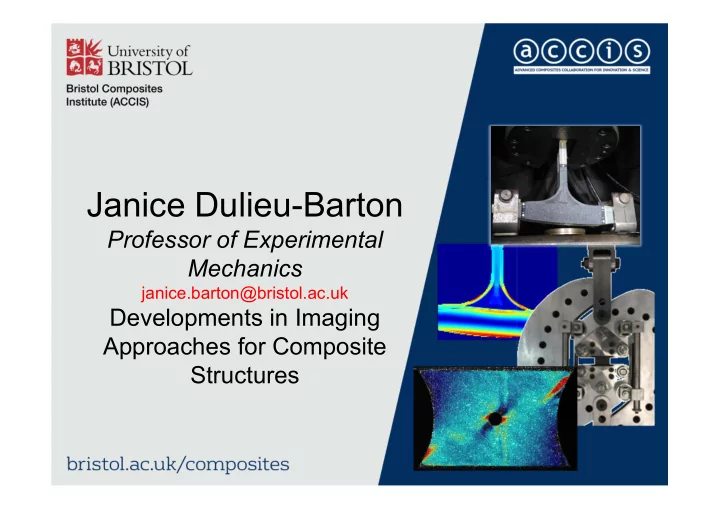

Janice Dulieu-Barton Professor of Experimental Mechanics janice.barton@bristol.ac.uk Developments in Imaging Approaches for Composite Structures
What is experimental mechanics? • Investigation by experimental means of the mechanical behaviour of engineering systems subjected to load • System can be a structure, a material, soft matter such as human tissue, a fluid-structure coupling….. • Measurement system (image based) is used to capture a quantity that describes the system’s behaviour • Seek information on deformation and Thermoelastic stress analysis (TSA) the mechanical strain • Full-field experimental data required to validate/verify numerical models • Derivation of failure parameters and material constitutive relationships
Research Interests • Imaging for data-rich materials characterisations and assessments of structural performance. • Lightweight structural design particularly composite structures. • Special focus on the development of infra-red imaging – thermoelastic stress analysis. • Integrating imaging and modelling. • Non destructive evaluation and structural health monitoring. • Structural scale testing
Imaging Systems -Full-field data -DIC Structures 2025 -TSA -High spatial resolution -High temporal resolution Strong floor - 1m thick reinforced concrete - 30 x 15 m - 1m spaced strong points - 500 kN vertical 25o kN Actuators: -Large load range -Synchronous control -Flexibility Hydraulics Load frames: - 1000 l/min ring main -Multi axial loading - Large deflections -Flexible set up - High loads -Large structures - ‘Plug and play’ -Modular design - Complex loading 4
Structures 2025 • A single integrated system • Unique internationally • Assessment of interactions between material failure mechanisms/modes and structural stiffness/strength driven failure modes • High level of physical realism and fidelity
3D Wind turbine blade substructure Root end Imaging device M �� N �� M �� N �� N �� Imaged field Geometric mapping N �� M �� Global load cases y z x Tip end Isolated substructure Global blade model Actual surface
3D Wind turbine blade substructure –loading concept M �� N �� M �� N �� N �� N �� M �� y z x Isolated substructure
Preliminary work – T-joint
Integrating data DIC TSA Data point FEA All datasets window Datum origin Data point values # Data points DIC – subset average DIC – 9 TSA – 25 TSA – pixel average FEA – 30 FEA – nodal value
Fused data – tension loading ��� ��� 𝑔 � = 𝜏 �� + 𝜏 �� ���� ∗ 𝑔 � = Δ𝑈 ���� ∗ Point-wise metric Line comparison Residual: 𝑔 � − 𝑔 � Poor surface Misaligned preparation datasets due to motion Fibre alignment Material property difference Normalisation point
Future challenges • Accounting for curvature - combining incorporates two camera infra-red imaging as well as stereo DIC • Low cost infra-red cameras are essential • Multiple camera systems • Devising an imaging approach that work can address multiple scales • Development and validation of ‘hybrid testing’ to enable the physical boundary and load conditions experienced in-service to be replicated and provide a realistic test environment • Quantify the impact on performance of meso/micro features and defects – in situ internal defect stress mapping using thermography
Recommend
More recommend